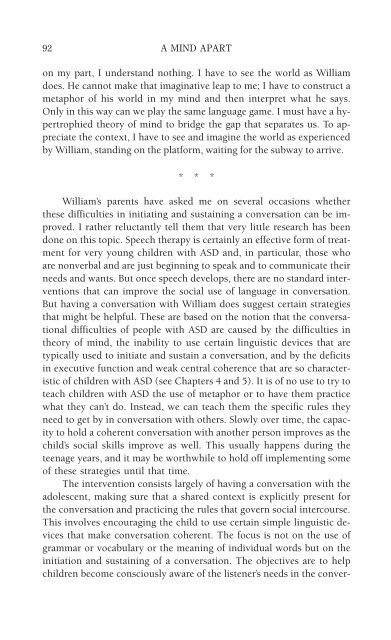978-1572305441
autism
autism
Create successful ePaper yourself
Turn your PDF publications into a flip-book with our unique Google optimized e-Paper software.
92 A MIND APART<br />
on my part, I understand nothing. I have to see the world as William<br />
does. He cannot make that imaginative leap to me; I have to construct a<br />
metaphor of his world in my mind and then interpret what he says.<br />
Only in this way can we play the same language game. I must have a hypertrophied<br />
theory of mind to bridge the gap that separates us. To appreciate<br />
the context, I have to see and imagine the world as experienced<br />
by William, standing on the platform, waiting for the subway to arrive.<br />
* * *<br />
William’s parents have asked me on several occasions whether<br />
these difficulties in initiating and sustaining a conversation can be improved.<br />
I rather reluctantly tell them that very little research has been<br />
done on this topic. Speech therapy is certainly an effective form of treatment<br />
for very young children with ASD and, in particular, those who<br />
are nonverbal and are just beginning to speak and to communicate their<br />
needs and wants. But once speech develops, there are no standard interventions<br />
that can improve the social use of language in conversation.<br />
But having a conversation with William does suggest certain strategies<br />
that might be helpful. These are based on the notion that the conversational<br />
difficulties of people with ASD are caused by the difficulties in<br />
theory of mind, the inability to use certain linguistic devices that are<br />
typically used to initiate and sustain a conversation, and by the deficits<br />
in executive function and weak central coherence that are so characteristic<br />
of children with ASD (see Chapters 4 and 5). It is of no use to try to<br />
teach children with ASD the use of metaphor or to have them practice<br />
what they can’t do. Instead, we can teach them the specific rules they<br />
need to get by in conversation with others. Slowly over time, the capacity<br />
to hold a coherent conversation with another person improves as the<br />
child’s social skills improve as well. This usually happens during the<br />
teenage years, and it may be worthwhile to hold off implementing some<br />
of these strategies until that time.<br />
The intervention consists largely of having a conversation with the<br />
adolescent, making sure that a shared context is explicitly present for<br />
the conversation and practicing the rules that govern social intercourse.<br />
This involves encouraging the child to use certain simple linguistic devices<br />
that make conversation coherent. The focus is not on the use of<br />
grammar or vocabulary or the meaning of individual words but on the<br />
initiation and sustaining of a conversation. The objectives are to help<br />
children become consciously aware of the listener’s needs in the conver-



